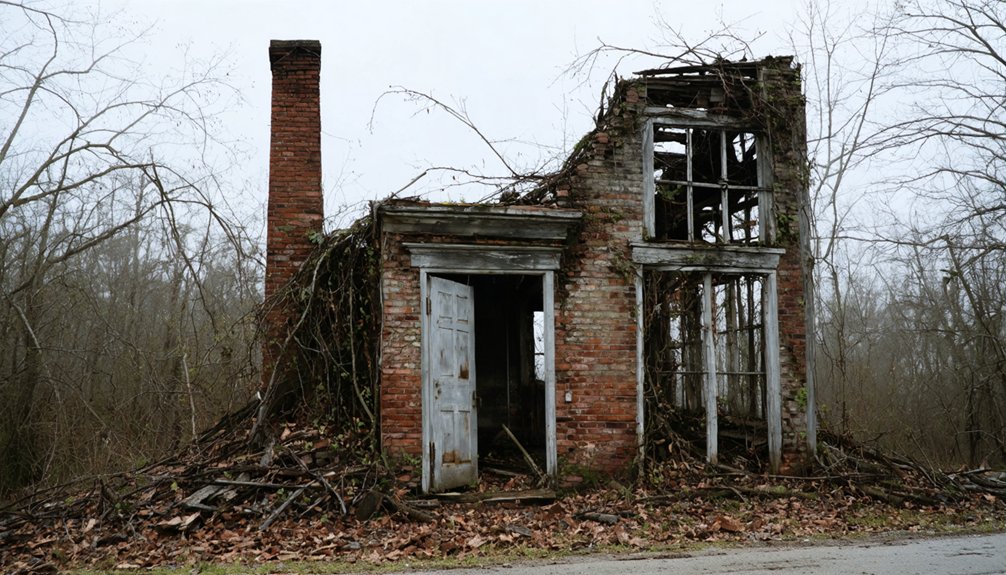You’ll find Vienna’s haunting remains along Alabama’s Tombigbee River, where a bustling river port once thrived from 1832 to 1917. Located in Pickens County, this ghost town‘s docks and warehouses handled over 2,000 cotton bales during its peak, connecting local farmers to southern markets. While only the historic Masonic Lodge still stands today, Vienna’s story of rise and decline reveals how shifting transportation methods transformed Alabama’s river commerce forever.
Key Takeaways
- Vienna was a thriving river trade town in Pickens County, Alabama, established in 1832 and known for cotton and timber shipping.
- Located 141 feet above the Tombigbee River’s eastern shore, Vienna served as a crucial transportation hub between Pickens and Sumter counties.
- The town’s decline began after the Civil War when railroads replaced river transportation as the primary means of commerce.
- By 1917, Vienna’s post office closed, and the town was completely disincorporated by 1920, with population dropping from 79 residents.
- Today, only the historic Masonic Lodge remains as evidence of Vienna’s existence as a once-prosperous river trading center.
The Rise of a River Port Town
While many 19th-century Alabama towns sprouted up along railroad lines, Vienna emerged as an essential river port on the eastern shore of the Tombigbee River.
Originally known as Cloud’s Town, the settlement incorporated in 1832 and quickly established itself as a significant hub for river trade and agricultural commerce.
You’d have found Vienna’s riverfront bustling with activity as steamboats and flatboats carried cotton shipments exceeding 2,000 bales per vessel.
The town’s strategic location facilitated trade with southern markets through an extensive network of docks and warehouses.
Similar to how the Danube River flows through modern Vienna, Austria, the Tombigbee’s waters were crucial to this Alabama town’s development.
In an era of limited road infrastructure, Vienna’s position on the Tombigbee gave merchants unparalleled access to regional trade routes.
The shallow-draft steamboat technology perfectly suited the southern rivers, making Vienna a powerhouse of commerce throughout the 1830s.
Local farmers relied on Vienna as their primary gateway for transporting cotton to Mobile and onwards to New Orleans.
Life Along the Tombigbee Waters
Life in Vienna revolved around the rhythms of the Tombigbee River, with daily activities unfolding 141 feet above its eastern shore. You’d find the community gathering at the river landing to welcome steamboats laden with goods, their arrivals marking crucial social occasions that brought scattered neighbors together.
River livelihoods shaped everything – from cotton and timber shipping to the seasonal patterns of trade and transport that sustained the town’s economy. The early steamboat era defined commerce and transportation until railroads began operating in the region. Today, the river carries between 6.5 and 7 million tons of cargo annually through the modernized waterway system.
Community traditions centered on the water’s edge, where you’d witness the bustle of commerce and connection. Though flooding posed constant risks, the townspeople adapted, building their lives above the floodplain while depending on the river’s bounty.
Life along the riverbank balanced risk and reward, as residents built their community high while staying connected to the water below.
You’d see ferries crossing daily, maintaining essential links between settlements until railroads eventually diminished the Tombigbee’s significance in daily life.
Economic Glory Days
Prosperity flowed through Vienna’s streets during its economic heyday of the 1830s-1860s. You’d have witnessed bustling docks along the Tombigbee River, where cotton from local plantations made its way to broader markets.
The town’s economic prosperity hinged on its strategic location as an essential river trade hub in southwestern Pickens County. Like Petersburg’s post office and newspaper, Vienna developed key infrastructure that supported its growing commercial importance.
With few reliable roads available, Vienna’s position as a market town made it indispensable to both local farmers and regional merchants. Similar to Bodie’s population of 10,000, Vienna thrived with a robust community that kept its commercial ventures humming. You’d have found well-established warehouses and merchant shops catering to the steady stream of river traffic.
The town’s commercial infrastructure supported a thriving economy that attracted settlers and traders alike, transforming this once-modest settlement into a significant regional powerhouse before the Civil War changed everything.
Transportation Evolution and Impact
Vienna’s identity as a transportation hub began with its strategic position on the Tombigbee River in the 1830s. You’d have found a bustling river port where steamboats carried cotton to Mobile, and an essential ferry crossing connected Pickens and Sumter counties for north-south travelers.
But the town’s river dominance wouldn’t last forever. Like the Middle Tennessee and Alabama Railroad that transformed Toney’s landscape in 1893, railroad expansion after the Civil War transformed the region’s transportation landscape.
You’ll notice how the rails offered faster, more efficient options that drew commerce away from the river. While ferries continued operating and steamboats still plied the Tombigbee into the early 20th century, Vienna’s prominence as a port town gradually faded.
The shift from water to rail routes changed everything – from local jobs to population patterns – ultimately contributing to Vienna’s transformation from a crucial port to a quieter community.
The Gradual Fade Into History
Though the town once flourished as an essential river port, the post-Civil War era marked the beginning of a steep decline for this Alabama settlement.
Like Beaver Mills’ paper mill, Vienna’s riverside location had initially made it a significant industrial center. Towns situated at river crossings were common gathering points for early settlements in Alabama. The closure of the post office in 1917 dealt another blow to Vienna’s existence, and by 1920, it had completely disincorporated.
You’ll find Vienna’s fading memory reflected in its stark population numbers – just 74 residents in 1900, climbing slightly to 79 in 1910, before the town’s official dissolution.
Today, this former riverside hub stands as a ghost town, with only the historic Masonic Lodge remaining as a symbol of its past significance.
The shift in transportation from river to rail sealed Vienna’s fate, transforming a once-bustling port into little more than a historical footnote in Pickens County’s chronicles.
Archaeological Remnants and Legacy
Despite the town’s complete dissolution, Vienna’s archaeological remnants offer a fascinating window into its past life as a bustling river port.
Archaeological findings reveal foundations of major buildings, including churches, a prison, and residential structures that once defined the town’s streetscape. You’ll find historical artifacts scattered throughout the site, from antique glass to industrial tools that tell the story of Vienna’s coal mining and lumber operations. Much like Spanish moss and wildflowers now adorn the ruins, nature has steadily reclaimed the area.
The town’s original street grid remains accessible, letting you explore the confluence of essential waterways that shaped Vienna’s destiny.
The site now serves as an archaeological park where you can discover preserved ruins and domestic objects from daily 19th-century life. These remnants paint a vivid picture of Vienna’s evolution from state capital to post-Civil War African American settlement before its ultimate abandonment.
Preserving Vienna’s Memory

As efforts to preserve Alabama’s historical legacy continue, the protection of Vienna’s archaeological treasures requires a multi-faceted approach involving state authorities, local communities, and preservation experts.
You’ll find that cultural documentation plays a crucial role in maintaining Vienna’s story through detailed archival records and historical research.
The Alabama Historical Commission works alongside local volunteers to safeguard the site’s remaining artifacts and structures.
Through community involvement, you can participate in workshops and educational programs that help keep Vienna’s history alive.
The SHPO’s office supports these preservation efforts by coordinating with federal agencies and securing necessary funding.
You’ll discover that sustainable preservation practices, combined with public awareness campaigns, guarantee that Vienna’s unique story endures for future generations to explore and understand.
Historical Significance in Modern Alabama
You’ll find Vienna’s historical significance embedded in its role as an early river commerce hub, where settlers established essential trade networks in northern Alabama.
The town’s strategic location and incorporation in 1832 showcase the development patterns of pre-Civil War settlement in Madison County.
Through Vienna’s preserved records and remaining structures, you can trace the evolution of Alabama’s river-based commerce and the economic forces that shaped early community development in the region.
Legacy of River Commerce
While Vienna’s physical remnants have largely vanished, the town’s legacy endures as a tribute to Alabama’s river commerce history.
You can trace the town’s rise and fall through the changing tides of river trade along the Tombigbee River, where steamboats once transported cotton and goods from the 1830s until the Civil War era. The economic shifts that transformed Vienna mirror the experience of other river towns like Colbert, Barton, and Vinton, which faced similar fates.
When the Mobile and Ohio Railroad arrived in 1858, it marked the beginning of Vienna’s decline, as river transportation gave way to faster rail service.
Today, this ghost town stands as a reminder of how transportation innovations can reshape communities and local economies.
Early Settlement Patterns Revealed
The rich tapestry of Vienna’s early settlement patterns offers key insights into Alabama’s territorial expansion and development. You’ll find that settler motivations centered on the promise of fertile land and river access, drawing families primarily from South Carolina, Tennessee, and neighboring states.
The community dynamics of early Vienna reflected a careful balance between independence and cooperation. Settlers valued their “elbow room” while maintaining peaceful coexistence despite their diverse origins.
They traveled long distances under challenging conditions, establishing farms and businesses along the Tombigbee River. Though initial population growth was intentionally slow, the settlement’s strategic location as a river port fostered a thriving market town.
These early pioneers created lasting institutions, including the Masonic Lodge and Post Office, which would later survive the town’s eventual decline.
Frequently Asked Questions
Are There Any Remaining Descendants of Vienna’s Original Inhabitants Still in Alabama?
Like scattered seeds in wind, you can’t conclusively trace family lineage of Vienna’s original residents in Alabama today. Historical records don’t definitively show if descendants remain within state borders.
What Specific Diseases or Epidemics Affected Vienna’s Population During Its Existence?
You’ll find limited records of specific disease outbreaks in Vienna, though the river port likely faced yellow fever, cholera, malaria, and smallpox – common health impacts in 19th-century Alabama river towns.
How Did Native American Communities Interact With Vienna’s Early Settlers?
You’ll find that Vienna’s settlers maintained trade relations with Creek Indians primarily, engaging in cultural exchange through bartering of goods and sharing agricultural knowledge along the Tombigbee River’s trading routes.
What Were the Most Common Occupations for Women in Vienna?
You’d find women primarily working as domestic servants, textile workers in nearby mills, or securing teaching positions. They also helped on family farms and occasionally worked as store clerks.
Did Any Notable Civil War Battles or Events Occur Near Vienna?
You’ll find several local skirmishes occurred near Vienna during the Civil War, including a notable July 1864 clash involving the Indiana 12th Cavalry that left one Union soldier dead and nine wounded.
References
- https://ahc.alabama.gov/properties/cahawba/cahawba.aspx
- https://digitalalabama.com/alabama-ghost-towns/alabama-ghost-towns/9449
- https://www.atlasobscura.com/articles/podcast-old-cahawba
- https://digitalalabama.com/article/alabama-ghost-towns/page/4
- https://freepages.history.rootsweb.com/~gtusa/usa/al.htm
- https://en.wikipedia.org/wiki/List_of_ghost_towns_in_Alabama
- https://unclesamsbackyard.wordpress.com/2013/10/04/where-in-the-world-is-vienna-alabama/
- https://en.wikipedia.org/wiki/Vienna
- https://encyclopediaofalabama.org/article/steamboats-in-alabama/
- https://www.southalabama.edu/org/archaeology/news/on-the-riverfront.html



